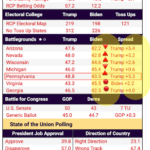
After being offline for a week in the country, I logged back onto social media to find my timeline filled with news of the assassination attempt on President Trump.
My first thought after realizing the perfect timing was,Let’s see how CNN puts it.“
And to my surprise, the first thing they wrote was:Trump falls at a rally and is hurriedly removed from the stage“
You might have had a similar thought process as me, and if so, you’ll agree that the media landscape has changed.
a lot.
Influenced by employees’ political leanings, the rise of cancel culture, and the need to make money, this shift has had a profound effect on how we view technology and Bitcoin (and pretty much everything).
So, what’s going on here?
Let’s take a closer look at what’s shaping media today.
There is no monolithic media elite
First, let’s make one thing clear: no secret cabal of media elites holds the real power.
The idea that capital “M” Media controls everything is simply not true.
That’s a myth.
What is actually happening is that many journalists are from elite schools like Columbia, Harvard, University of Pennsylvania, etc. This trend has given the media a liberal bias, not because of some grand conspiracy, but because of the backgrounds and views of the people creating the news.
This liberal bias has especially affected coverage of technology and Bitcoin, with left-leaning media essentially Anti-technology.
Liberals have generally been wary of Bitcoin’s rapid technological advances and decentralized nature, which they see as a threat to regulation and the traditional financial system.
The rise of cancel culture
Another factor is the rise of cancel culture over the past decade, in which individuals and companies are publicly criticized for their controversial views or actions.
This has also had a major impact on media companies, with journalists feeling the need to conform their reporting to the prevailing public perception to avoid backlash.
As a result, media companies have become more willing to let their employees’ political biases influence their content.
Now, you might think that this is different from the mainstream media of previous decades, and that they were aiming for a more balanced, less politically charged media.
To be sure, in hot topics like technology and Bitcoin, political bias often overshadows fact-based reporting, but this is nothing new.
Pursuing the truth and making money
At the heart of media management is the conflict between discovering the truth and making money.
These companies make money in two ways: through advertising, which connects potential buyers and sellers, and through subscriptions, which include consumer subscriptions (such as a $10 per month news subscription) and business subscriptions (such as buying a Bloomberg terminal).
Looking back over the past 15 years, the days of mass publications are over. Today, media thrives on both extremes.
For example, the New York Times Surprisingly wellSome people may not realize that The New York Times is actually a product company at this point, with 30-40% of its revenue coming from games and cooking, and another big chunk coming from subscriptions.
The point is that while journalism ideally aims to uncover and report the truth, the economic reality is different.
As media companies need to attract audiences and generate revenue in various ways, it is important for them to cater to audience needs and address bias in the media, especially in the digital age where bias is more pronounced. Sometimes it comes at the expense of objective truth or even actual journalistic work in favor of what brings in revenue.
This explains why media outlets tailor their content to suit audience preferences.
Editorial decisions about which stories to feature and how to frame an issue are driven not only by the story itself but by whether it will attract readers and viewers to the multimedia ecosystem that the media wants to provide in order to remain relevant and economically viable.
A Historical Perspective on Media Bias
But while these different revenue streams are new approaches to media, bias itself is not.
During the American Civil War, newspapers openly supported certain political factions.“Copperhead Democrat” To find out which side each of the three different media outlets stands on.
Today’s media works in exactly the same way, but with some modern complexities.
Digital platforms and algorithms that curate content based on user preferences have strengthened echo chambers, ensuring people are primarily exposed to information that confirms their existing beliefs.
This echo chamber effect exacerbates media bias as media outlets produce content that aligns with audience opinions to maintain their interest.
For tech and bitcoin, this means negative narratives take hold and prejudice becomes harder to combat.
Bitcoin is not for everyone
In an opinion piece last year, I wrote: Bitcoin is not for everyoneSo, we need to look at a specific group, and the Bitcoin and tech industry as a whole needs to understand this and get through it.
It’s okay to have bias on certain topics because that’s part of the media, the problem comes when that bias leads to writing articles that aren’t factually based.
And that’s why people have come to hate the mainstream media as a whole — not because it’s biased, but because that bias often overwhelms fact-based reporting. This is a relatively new phenomenon.
And judging by the looks of things, this may continue, or media organisations may realise that if they continue this way they will lose the trust of their audiences.
Or perhaps the lesson is the opposite. Too neutralYour viewers may then react negatively and try to cancel or back out of your subscription.
Most media organizations, including CNN, The New York Times, and Fox News, know what their audiences want to hear, and it is only when they tell the exact opposite story that they face rebellion.
So, be selective in your content consumption.
Because as scary as the world is right now, I know it’s only going to get worse.
This is a guest post by Fernando Nikolic. The opinions expressed here are entirely Nikolic’s own and do not necessarily reflect the opinions of BTC Inc or Bitcoin Magazine.







